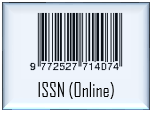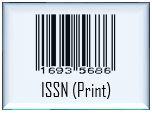THERAPY ADHERENCE OF 40-75 Y.O. HYPERTENSION RESPONDENTS USING MORISKY INSTRUMENT IN NGEMPLAK, SLEMAN, DIY (STUDY ON AGE, DEMOGRAPHY, SOCIAL, AND LIFE-STYLE FACTORS)
Abstract
Keywords
Full Text:
PDFReferences
Ahmed, S., 2015. Assessment of Adherence to Antihypertensive Treatment Among Patients Attending A Health Care Facility in North India. Int J Res Med., 4 (1), 117-124.
Ambaw, A.D., Getahun, A.A., Solomon, M., Yohanes., Zelalem, B.M., 2012. Adeherence to Antyhypertensive Treatment and Associated factor Among Patients on Follow Up At University of Gondar Hospital, Northwest Ethiopia. BMC Public Health, 12 (282), 1-6.
Arief, M., 2008. Pengantar Metodologi Penelitian untuk Ilmu Kesehatan.
Chobanian, A.V., Bakris, G.I., Black, H.R., Cushman, W.C., Green, L.A., Izzo, J.I, et al., 2003. The Seventh Report of The Joint National Comittee on Prevention, Detection, Evaluation, And Treatment of High Blood Pressure. The JNC Report, 289 (19), 2560-2572.
Cuevas, C., Penate, W., 2015. Psychometric Properties of The Eight-Item Morisky
Medication Adherence Scale (MMAS-8) in a Psychiatric Outpatient Setting. Int J Clin and Health Psychol., 15, 121-129.
Dahlan, M.S., 2013. Statistik untuk Kedokteran dan Kesehatan.
Dehghan, M., Dehghan-Nayeri, N., Iranmanesh, S., 2015. Translation and validation of The Persian Version of The Treatment Adherence Questionnaire for Patients with Hypertension. ARYA Atheroscler, 12 (2), 76-86.
Demoner, M.S., Ramos, P.E.R., Pereira, E.R., 2012. Factors Associated with Adherence
to Antihypertensive Treatment in a Primary Care Unit. Acta Paul Enferm, 25 (1), 27-34.
Despres, F., Perreault, S., Lalonde, L., Forget, A., Kettani, F.Z., Blasi, L., 2014. Impact of Drug Plans on Adherence to and the Cost of Antihypertensive Medications Among Patients covered by A Universal Drug Insurance Program. Canadian Journal of Cardiology, 30, 560-567.
Dinas Kesehatan DIY, 2013. Profil Kesehatan Daerah Istimewa Yogyakarta Tahun 2013.
Dinas Kesehatan Sleman, 2011. Kesehatan Usia Lanjut. http://dinkes.slemankab.go.id/kesehatan-usia-lanjut, accessed on 21 April 2016.
Gosmanova, E.O., Mikkelsen, M.K., Molnar, M.Z., Lu, J.L., Yessayan, L.T., Kalantar-Zadeh, K., Kovesdy, C.P., 2016. Association of Systolic Blood Pressure Variability with Mortality, Coronary Heart Disease, Stroke, and Renal Disease. J Am Coll Cardiol, 68 (13), 1375-86.
Hazwan, A., Pinatih, G.,N., 2017. Gambaran karakteristik penderita hipertensi dan tingkat kepatuhan minum obat di wilayah kerja puskesmas Kintamani I. Intisari Sains Medis, 8 (2), 130-134.
Jin, J., Sklar, G.E., Oh, V.M.S., Li, S.C., 2008. Factors Affecting Therapeutic Compliance: A Review From Patients Perspective. Ther Clin Risk Manag., 4 (2), 269-283.
Kamran, A., Sadeghieh A. S., Biria M., Malepour A., Heydari H., 2016. Determinants of Patients Adherence to Hypertension Medications: Application of Health Belief Model Among Rural Patients. Ann Med Health Sci Res., 6 (4), 922-927.
Kementrian Kesehatan RI, 2013. Riset Kesehatan Dasar: RISKESDAS 2013.
Kementrian Kesehatan RI, 2014. Pusat Data dan Informasi Kementerian Kesehatan RI: Hipertensi.
Lee, G.K.Y., Wang, H.H.X., Liu, K.Q.L., Cheung, Y., Morisky, D.E., Wong, M.C.S., 2013. Determinants of Medication Adherence to Antihypertensive Medication Among a Chinese Population Using Morisky Medication Adherence Scale. 8 (4), 1-7.
Li, W.T.L., Kang, C.D., Tsang, P., Wang, H., Liu, K., Chan, W.M., Wong, M.C.S.,
Determinants of Medication Adherence and Blood Pressure Control Among Hypertensive Patients in Hong Kong: A Cross-sectional Study. Int J Cardio, 14, 1-23.
Morisky, D.E., Ang, A., Krousel-Wood M., Ward, H.J., 2008. Predictive Validity of A Medication Adherence Measure In An Outpatient Setting. J Clins Hypertens, 10 (5), 348-354.
Najimi, A., Mostafavi, F., Sharifirad, G., Golshiri, P., 2016. Barriers to Adherence to Pharmacotherapy among Patient with Hypertension: A Cross-Sectional Study. Int J Med Res Health Sci., 5 (7S), 46-53.
National Health Service, 2016. Cause of High Blood Pressure (Hypertension). http://www.nhs.uk/Conditions/Blood-pressure-(high)/Pages/Causes.aspx, accessed on 13 January 2017.
Noorhidayah, S.A., 2016. Hubungan Kepatuhan Minum Obat Antihipertensi Terhadap Tekanan Darah Pasien Hipertensi di Desa Salamrejo.
Pinto, E., 2006. Blood pressure and ageing. Postgrad Med J., 83, 109-114.
Pratiwi, I.P., dan Perwitasari, M., 2017. Analisis Faktor-Faktor yang Mempengaruhi Kepatuhan Pasien Hipertensi dalam Penggunaan Obat di RSUD Kadinah. dalam: 2nd Seminar Nasional IPTEK Terapan, SENIT 2017. 204-208.
Puspita, E., 2016. Faktor-Faktor yang Berhubungan dengan Kepatuhan Penderita Hipertensi dalam menjalani Pengobatan.
Ramli, A., Ahmad, N.S., Paraidathathu, T., 2012. Medication Adherence Among Hypertensive Patients of Primary Health Clinics in Malaysia. Patient Preference and Adherence, 2012 (6), 613-622.
Rigby, D., 2015. Drug Adherence in Hypertension: Challenges and Opportunisties. Australas J Pharm. (96), 64-67.
Saepudin, S.P., Hidayanti, P dan Ningsih, E.S., 2013. Kepatuhan Penggunaan Obat pada Pasien Hipertensi di Puskesmas. Jurnal Farmasi Indonesia, 6 (4), 249.
Susilo, N.V., 2015. Prevalensi, Kesadaran, Terapi, dan Pengendalian Tekanan Darah
Responden 40-75 Tahun di Kecamatan Kalasan, Sleman, DIY (Kajian Faktor Umur dan Pengaturan Diet).
Tan, X., Patel, I., Chang, J., 2014. Review of the four item Morisky Medication Adherence Scale (MMAS-4) and eight item Morisky Medication Adherence Scale (MMAS-8). Inov Pharm, 5 (3), 1.
Vankatachalam, J., Abrahm, S. B., Singh, Z., Satya, S., 2015. Determinants of
Patients Adherence to Hypertension Medications in a Rural Population of Kancheepuram District in Tamil Nadu, South India. Indian J Community Med., 40 (1), 33-37.
Warren-Findlow, J., Seymour, R.B., Huber. L.R.B., 2012. The Association Between Self-Efficacy and Hypertension SelfCare Activities Among African American Adults. J Community Health, 37 (1), 5.
DOI: https://doi.org/10.24071/jpsc.00533
Article Metrics
Abstract view : 3176 timesPDF view: 779 times
Refbacks
- There are currently no refbacks.
Copyright (c) 2017 Journal of Pharmaceutical Sciences and Community
Jurnal Farmasi Sains dan Komunitas (Journal of Pharmaceutical Sciences and Community)
Published by Faculty of Pharmacy, Universitas Sanata Dharma Yogyakarta

This work is licensed under a Creative Commons Attribution 4.0 International License.













.png)













